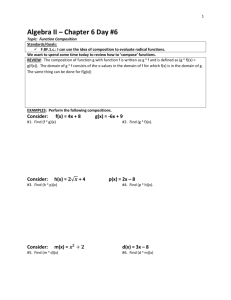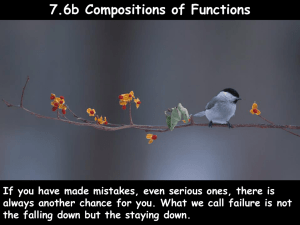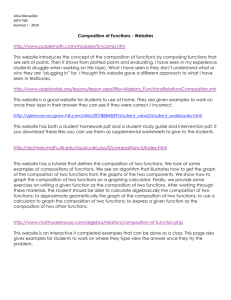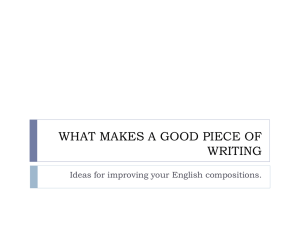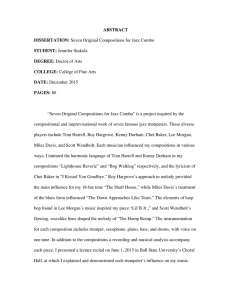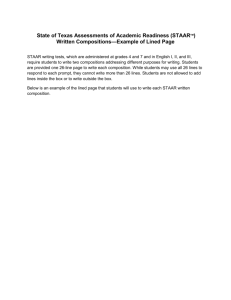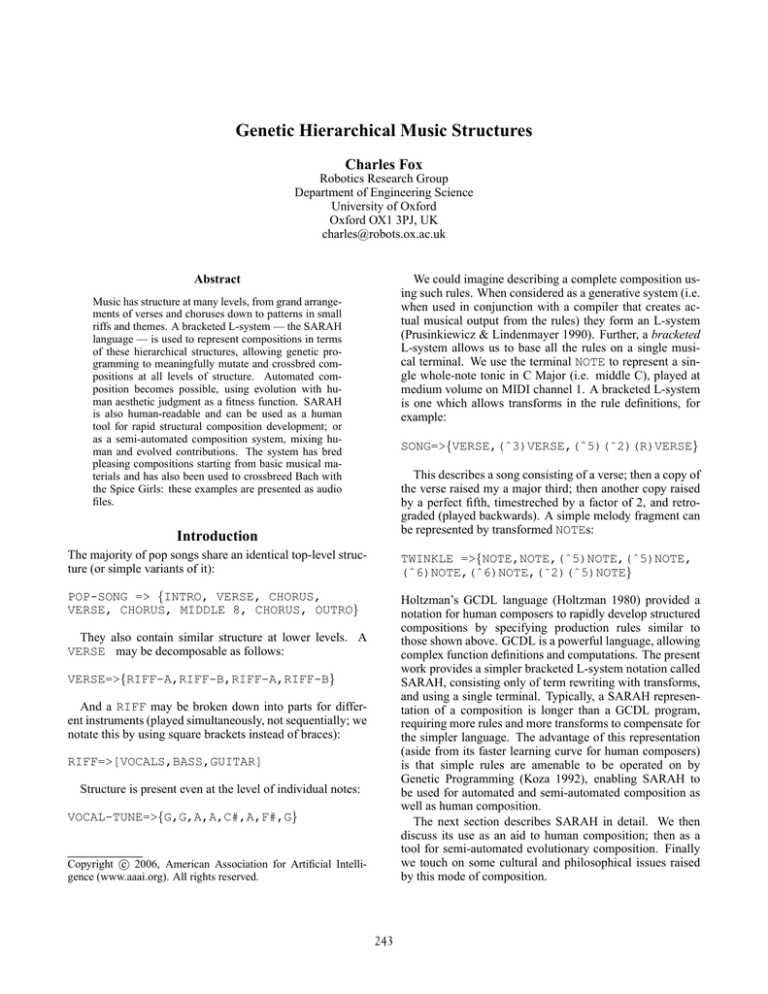
Genetic Hierarchical Music Structures
Charles Fox
Robotics Research Group
Department of Engineering Science
University of Oxford
Oxford OX1 3PJ, UK
charles@robots.ox.ac.uk
Abstract
We could imagine describing a complete composition using such rules. When considered as a generative system (i.e.
when used in conjunction with a compiler that creates actual musical output from the rules) they form an L-system
(Prusinkiewicz & Lindenmayer 1990). Further, a bracketed
L-system allows us to base all the rules on a single musical terminal. We use the terminal NOTE to represent a single whole-note tonic in C Major (i.e. middle C), played at
medium volume on MIDI channel 1. A bracketed L-system
is one which allows transforms in the rule definitions, for
example:
Music has structure at many levels, from grand arrangements of verses and choruses down to patterns in small
riffs and themes. A bracketed L-system — the SARAH
language — is used to represent compositions in terms
of these hierarchical structures, allowing genetic programming to meaningfully mutate and crossbred compositions at all levels of structure. Automated composition becomes possible, using evolution with human aesthetic judgment as a fitness function. SARAH
is also human-readable and can be used as a human
tool for rapid structural composition development; or
as a semi-automated composition system, mixing human and evolved contributions. The system has bred
pleasing compositions starting from basic musical materials and has also been used to crossbreed Bach with
the Spice Girls: these examples are presented as audio
files.
SONG=>{VERSE,(ˆ3)VERSE,(ˆ5)(˜2)(R)VERSE}
This describes a song consisting of a verse; then a copy of
the verse raised my a major third; then another copy raised
by a perfect fifth, timestreched by a factor of 2, and retrograded (played backwards). A simple melody fragment can
be represented by transformed NOTEs:
Introduction
The majority of pop songs share an identical top-level structure (or simple variants of it):
TWINKLE =>{NOTE,NOTE,(ˆ5)NOTE,(ˆ5)NOTE,
(ˆ6)NOTE,(ˆ6)NOTE,(˜2)(ˆ5)NOTE}
POP-SONG => {INTRO, VERSE, CHORUS,
VERSE, CHORUS, MIDDLE 8, CHORUS, OUTRO}
Holtzman’s GCDL language (Holtzman 1980) provided a
notation for human composers to rapidly develop structured
compositions by specifying production rules similar to
those shown above. GCDL is a powerful language, allowing
complex function definitions and computations. The present
work provides a simpler bracketed L-system notation called
SARAH, consisting only of term rewriting with transforms,
and using a single terminal. Typically, a SARAH representation of a composition is longer than a GCDL program,
requiring more rules and more transforms to compensate for
the simpler language. The advantage of this representation
(aside from its faster learning curve for human composers)
is that simple rules are amenable to be operated on by
Genetic Programming (Koza 1992), enabling SARAH to
be used for automated and semi-automated composition as
well as human composition.
The next section describes SARAH in detail. We then
discuss its use as an aid to human composition; then as a
tool for semi-automated evolutionary composition. Finally
we touch on some cultural and philosophical issues raised
by this mode of composition.
They also contain similar structure at lower levels. A
VERSE may be decomposable as follows:
VERSE=>{RIFF-A,RIFF-B,RIFF-A,RIFF-B}
And a RIFF may be broken down into parts for different instruments (played simultaneously, not sequentially; we
notate this by using square brackets instead of braces):
RIFF=>[VOCALS,BASS,GUITAR]
Structure is present even at the level of individual notes:
VOCAL-TUNE=>{G,G,A,A,C#,A,F#,G}
c 2006, American Association for Artificial IntelliCopyright °
gence (www.aaai.org). All rights reserved.
243
(R) retrograde (play backwards)
(I) inversion (reflect pitches about the tonic)
We use a scale-degree representation of pitch. Each note
is represented by a 6-tuple: (key, degree, time, duration, volume, channel). Key is an integer MIDI note number which
represents the root note of the (relative) Ionian major scale
that the note is in. For example, for a piece in C major, D Dorian or A Aeolian it could be 60 (C3/middle C). For a piece
in D Major, E Dorian or B Aeolian it could be 62 (D3). The
pitch is then determined by the scale degree within that key.
So in key 60 (C3 Ionian), a note of degree 3 would be the major third of the scale rooted on C3, i.e. E3. A note of degree
10 would be major tenth, i.e. E4. At present the scale pattern
is fixed to the Ionian scale, allowing melodies in standard
western modes to be represented without changing key. To
represent accidentals, one must make a key change as well
as a degree shift. For example, the following shows how to
notate the melody A3,F3,B3 in G Major:
Figure 1: The compiled tree for Happy Birthday
Figure 2: The compiled score for Happy Birthday
The SARAH Language
TUNE=>{(ˆ2)NOTE,(&-5)(ˆ4)NOTE,(ˆ3)NOTE}
SONG=>{(&5)TUNE}
A composition is represented in SARAH by a list of contextfree term-rewrite rules. The right-hand sides of the rules are
enclosed in braces or square brackets to represent whether
the structure is to be played melodically (in series) or harmonically (in parallel) respectively. Within these brackets is
a list of structure names. The names must refer to structures
that are previously defined in the list, or may be the terminal
NOTE. Each name may be prefixed by a list of transforms.
For example, here is Happy Birthday written in SARAH:
Recall that each NOTE starts out as the tonic in C3 Major.
So SONG shifts the key of TUNE up a fifth to G3 Major.
TUNE itself defines the melody, the second note of which is
the fourth degree of a new key - changed down a fifth back
to C Major. The accidental is thus conceived of as occurring
in a temporary mode change.
We use the scale-degree representation for two related
reasons. First, from a cognitive viewpoint, we believe it is
closer to the way that human musicians think about music
than absolute pitches are. It provides a higher level of abstraction for the composer to make use of: once she has
changed to F minor she can then think and write in terms
of that scale rather than have to worry about how to translate
from that scale into absolute pitches. Secondly, we find it
gives rise to more aesthetically pleasing compositions from
the genetic composition system discussed later. This is because it allows the system to make musical changes at this
cognitively meaningful layer. So for example, it may change
the key or mode of a whole section of music with a single
mutation; or shift the degrees of random notes within their
home scale.
a => {NOTE, NOTE}
m => {(˜2)NOTE}
down1 => {(ˆ5)NOTE, (ˆ3)NOTE, NOTE}
down2 => {(ˆ-2)NOTE, (ˆ-3)NOTE}
s => {(˜2)m}
c => {(ˆ2)m, m}
b => {a, c}
2u => {m, (ˆ-2)s}
hb => {(ˆ-4)b}
last => {(ˆ3)m, m, (ˆ2)m, m}
hb2u => {hb, 2u}
2hb2u => {hb, (ˆ2)2u}
middle => {(ˆ-4)a, (˜2)down1, (˜2)down2}
3hb2u => {(ˆ4)a, last}
song => {hb2u, 2hb2u, middle, 3hb2u}
harmony => [song, (ˆ3)song]
Human Composition
We have created a GUI environment for human composers to
quickly edit, compile and view SARAH compositions (fig.
3). The user can examine the tree and score representations
of the complete score or sub-scores, and may also force particular types of genetic operations to occur. This environment is called Music Genie. Audio example 1 presents a
short minimalist-style composition written by a human using Music Genie. The composer commented that he was
able to develop this composition much faster than by hand
due to his enhanced abilities to replicate and transform existing structures.
This generates the tree shown in fig. 1. Applying the
transforms to the leaves gives the melody shown in fig. 2.
Note that there is no nesting of brackets or transforms within
each rule, as is generally allowed in bracketed L-systems.
The possible transforms are:
(ˆn) shift pitch by n scale degrees
(&n) shift key by n scale degrees
(˜n/m) timestretch by rational n/m
(n/m) multiply amplitude by rational n/m
244
Following Koza’s conception of Genetic Programming
(Koza 1992), we consider consider each rule in a SARAH
composition to be a gene, and the complete composition
as a genome. As with Genetic Algorithms, Genetic Programming requires four operations to be specified: mutation
methods, crossover methods, a fitness function and an initial
population.
genomes are ordered lists. For example, genes may only refer to names of genes defined earlier than themselves in the
genome (to prevent circular definitions). This ordering gives
an admittedly crude heuristic for analogy-making. Call each
genes position in the genome its level. To perform crossover, use the following algorithm, whose action is illustrated
in fig. 4:
for each child c do
for each level i do
p ← randomly chosen parent
g ← ith gene of p
copy g into c’s genome
for each name n on the RHS of g do
gr ← the gene in p with name n
if gr was previously copied to c then
do nothing
else
j ← the level of gr in p
pold ← the parent whose level j gene was
copied to c
nold ← name of the level j gene in pold
in c’s copy of g, substitute nold for n
end if
end for
end for
end for
Mutation
Fitness Function
We use the following mutation types: Random transforms
may be inserted into genes. Existing transforms may
have their numeric arguments altered. Transforms may be
deleted. Random structure names may be inserted into
genes (subject to their structures being defined higher in the
genome). Structure names may be removed from genes.
Melodic and harmonic structures may be flipped (i.e. the
square brackets replaced by braces and vice versa). New
random genes may be added to the genome. Genes may be
deleted from the genome (subject to all references to them
being removed also). Each of these mutation types has a
probability, set by hand.
Whilst it may be possible to automate some human aesthetic
preferences and encode a fitness function based on them, we
take a human-driven approach to evolution. Music Genie
includes a GUI (fig. 5) that presents users with a current
population of compositions and asks them to select their favorites. These selections are used as parents to breed the
next generation. We do however use a single, very basic
heuristic that screens out compositions containing less than
5 notes. This was added because the heuristic cross-over
system described above can sometimes lead to badly-drawn
analogies which produce very short compositions. An interesting open question is to what extent automated fitness
functions are possible: could and should we for example
screen out compositions that change key too often, or whose
rhythmic structures are irregular? There is of course a tradeoff here: restricting the space of possible compositions in
exchange for requiring the user to spend less time selecting
out ‘obviously’ bad ones.
We have also implemented a web-based client-server version of this GUI that allows many users to collaborate on
evolving compositions.
Figure 3: Music Genie’s composition environment
Evolution
Crossover
Crossover is more complex. We would like to combine two
different compositions in a musically meaningful way. Because our genes represent hierarchical structures, and we are
using the scale-degree representation, it is possible to do this
in an elegant way. To create a child from some parents,
we choose random genes from each parent and put them together to form a new genome. When a selected gene from
parent p refers to other structures from p whose genes were
also selected, then their names are preserved in the child.
When it refers to structures whose genes were not selected,
we must change the names to refer to an ‘analogous’ structure in the child. Choosing the ‘most analogous’ structure
is a difficult problem: analogy-making is an active area of
research (Hofstadter 1996), (Gentner, Holyoak, & Kokinov
2002) and we do not yet know the best way to go about
it. At present we use a simple heuristic. Recall that the
Initial Population
The evolution system may be initialized by loading a set of
human compositions as the initial parents; alternatively, single NOTE terminals could be used, so that the compositions
grow entirely from evolved material. In practice we prefer
the first option as it would take many generations of uninteresting compositions before the second method produced
interesting results. Cross-over and mutation may also be
245
Figure 4: Example of the crossover process.
it. Practical improvements could be made by implementing
basic automatic fitness screening to save wasted user time
listening to ‘obviously bad’ compositions. A related issue
is that of limiting or probabilistically weighting the initial
choices of mutations to avoid those which produce ‘obviously bad’ changes.
Discussion
Figure 5: Music Genie’s evolution manager
We present SARAH and Music Genie not only as a useful
tool for human composers and a fun way of evolving short
compositions, but as raising questions about the nature of
creativity: to what extent should creativity be credited to the
machine and to the human(s) who participate in evolutions?
A criticism of machine composition (e.g. (Cope 2001)) is
that it cannot currently be called ‘artistic’ because it does not
deliberately express anything: it does not start with a conceptual model of emotions or stories to be conveyed by the
language of music. If a machine was to produce Beethoven’s
Ninth by chance, it would still not be artistic unless it had
started with a model of what it is like to be hurtling through
a thunderstorm in the rain. Rather, this creative credit should
be granted to the human curator who selects that chance
composition — probably after considerable effort spent listening to millions of others — and perceives it as expressing
those concepts. The chance composition acts like a ‘found
object’. Hence the composer becomes synonymous with the
curator.
Music Genie suggests a further shift in this direction, from
the curator-as-composer to the listener-as-composer (fig. 6).
Reminiscent of Turing’s notion of mathematical creativity
(Turing 1938), listener-composers inject emotion and meaning to the creative process, but the laborious work of creating
the actual structures and notes is performed by the machine.
The composition could exist as a permanently-evolving population, and every listening acts as a further step in the evolution. The credit for composition should then be assigned
to the community of listeners themselves rather than an èlite
creator or curator.
run manually from the human composition environment in
Music Genie, allowing a human composer to generate new
works by controlled evolution of his existing works.
Results
Audio example 2 presents a typical example of a user working with the web-based selection system to evolve a new
composition. Audio example 3 presents the result of such
an evolution after about 100 generations. Audio example 4
illustrates the effects of various random mutations on an extract from Bach’s Well Tempered Clavier, and the effect of
crossbreeding it with an extract from the Spice Girls song
Wannabe. Most listeners find these compositions to be reasonably aesthetically pleasing.
Future Work
At present, the input compositions must be manually parsed
into SARAH, by musically trained humans. This is time
consuming and appears to require considerable intelligence
and pattern recognition skills. Future work could examine
the use of grammar induction methods to automate some
or all of this process. See for example (Reis 1999) for an
agent-based discussion of this area. Composers have also
commented that the syntax can become unwieldy, is difficult to type, and could be simplified.
At present the alignment method used in crossover is
heuristic, and future work could examine the use of structure mapping or other analogy-making methods to improve
246
t => {B, C, D, E}
tt => {t, (&5)t}
pause => {(@0)(ˆ5)B, (@0)(ˆ5)C, (@0)a}
delayed => {pause, Bold, Cold, Dold}
z => [tt, (v1)delayed]
The following is the code for the Spice Girls example:
A => {NOTE}
C => {NOTE}
dd => {(˜3)(@5/4)(ˆ-8)A, (ˆ-8)A}
tail => {(ˆ-2)(˜3/2)(@5/4)(ˆ-8)A,
(˜3/2)(ˆ-2)(ˆ-8)A, (ˆ-2b)(ˆ-8)A}
riff => {dd, (ˆ3)dd, (ˆ4)dd, tail}
chord => [A, (ˆ3)A, (ˆ5)A]
cnb => [(v1)(@2/3)chord, (@3/2)A]
dedah1 => {(˜3)(ˆ-4)cnb, (ˆ-3)(˜5)cnb}
dedah2 => {(˜3)(ˆ-5)cnb, (˜5)cnb}
tellme => {(˜1/2)(@2)A, (˜1/2)A, (˜1/2)A,
(˜1/2)A, A, (˜1/2)A, (˜1/2)A}
rvox => {tellme, tellme, tellme, tellme}
riffnvox => [riff, (v2)rvox]
2riffs => {riffnvox, riffnvox}
riffphrase => {($6)(&6)2riffs}
ifyouwanna => {(@5/4)(ˆ5)C, (ˆ5)C,
(ˆ5)C, (ˆ5)C}
bemylover => {(@5/4)(ˆ5)C, (ˆ6)C, (ˆ5)C,
(˜3)(ˆ3)C}
youhavegottoknow => {(@5/4)(ˆ2)C, C,
(ˆ2)C, C, (ˆ3)(˜3)C}
lineA => {(˜1/2)ifyouwanna, bemylover,
youhavegottoknow}
Abass => {dedah1, dedah2}
lineAall => [lineA, (v5)Abass]
lineAallH => [lineA, (ˆ3)lineA, (v5)Abass]
thatsthewayitis => {(@5/4)(ˆ8)(˜1)C,
(ˆ8)C, (ˆ9)C, (ˆ5)C, (ˆ6)(˜2)C, (ˆ5)(˜2)C}
lineB => {(˜1/2)ifyouwanna, bemylover,
thatsthewayitis}
lineBall => [lineB, (v5)Abass]
lineBallH => [lineB, (ˆ3)lineB, (v5)Abass]
verse => {lineAall, lineBall,
lineAallH, lineBallH}
song => {riffphrase, (v1)(ˆ8)verse,
riffphrase, (v1)(ˆ8)verse}
Figure 6: The creative process for semi-automated composition
References
Cope, D., ed. 2001. Virtual Music: Computer Synthesis of
Musical Style. Cambridge, MA, USA: MIT Press.
Gentner, D.; Holyoak, K. J.; and Kokinov, B. K., eds.
2002. The Analogical Mind: Perspectives from Cognitive
Science. Cambridge, MA, USA: MIT Press.
Hofstadter, D. R. 1996. Fluid Concepts and Creative
Analogies: Computer Models of the Fundamental Mechanisms of Thought. New York, NY, USA: Basic Books,
Inc.
Holtzman, S. 1980. Generative Grammars and the Computer Aided Composition of Music. Ph.D. Dissertation, Edinburgh University.
Koza, J. R. 1992. Genetic Programming: On the Programming of Computers by Means of Natural Selection.
Cambridge, MA, USA: MIT Press.
Prusinkiewicz, P., and Lindenmayer, A. 1990. The algorithmic beauty of plants. New York, NY, USA: SpringerVerlag New York, Inc.
Reis, B. Y. 1999. A multi-agent system for on-line modeling, parsing and prediction of discrete time series data. In
Intelligent Image Processing, Data Analysis and Information Retrieval. IOS Press Holland. pp. 164–169.
Turing, A. M. 1938. Systems of Logic based on Ordinals.
Ph.D. Dissertation, Princeton University.
Appendix
The following is the code for the Bach example:
The MP3 audio examples and Music Genie software are
freely available from www.charlesfox.org.uk.
a => {($6)(&5)NOTE}
Bold => {a, (ˆ3)a, (ˆ-4)a, (˜2)(ˆ-5b)a,
(˜3)(ˆ-4)a}
Cold => {(˜1/2)(ˆ-3)a, (˜1/2)(ˆ-2)a, a,
(˜1/2)(ˆ-2)a, (˜1/2)(ˆ-3)a, (ˆ-2)a}
Dold => {(ˆ3)Cold, (ˆ6)Cold}
B => {(ˆ5)a, (ˆ5#)(@5/4)a, a,
(˜2)(ˆ-2b)(@5/4)a, (˜3)(@5/4)a}
C => {(˜1/2)(ˆ2)a, (˜1/2)(ˆ3)a, (ˆ4)a,
(˜1/2)(ˆ3)a, (˜1/2)(ˆ2)a}
D => {(ˆ3)(˜2)a, (˜3)a, (˜1/2)(ˆ2)a,
(˜1/2)a, (ˆ-2)a, (˜1/2)a,
(˜1/2)(ˆ2)a, (ˆ3)a, a,
(ˆ-3)a, (ˆ4#)a}
E => {(ˆ5)(˜3)a, (ˆ6#)a, (ˆ7)a, (ˆ6#)a,
(ˆ7)a, (ˆ8)a, (ˆ9)a}
247

